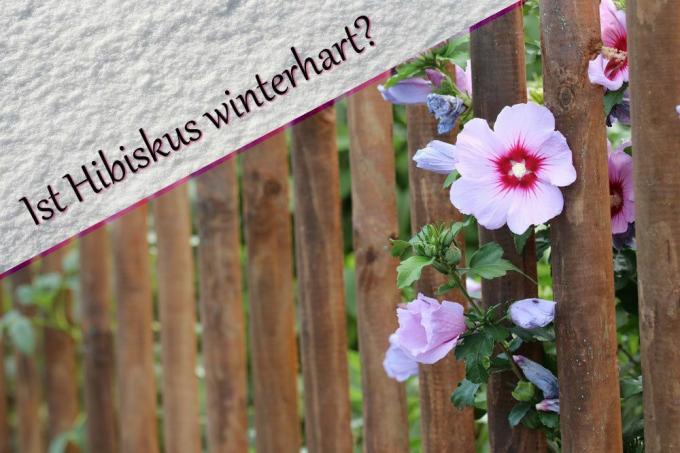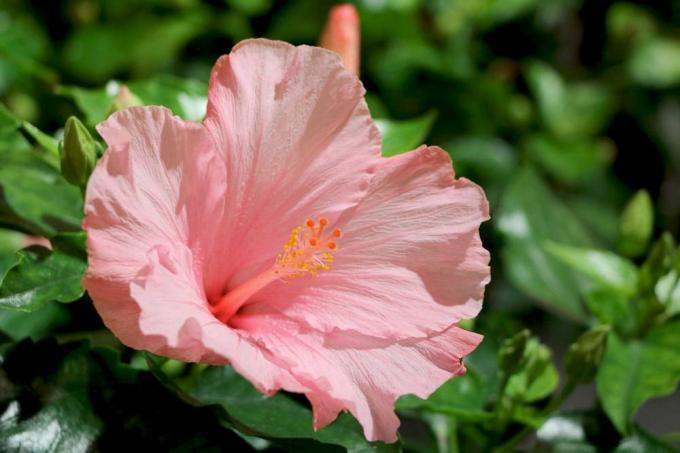
table of contents
- Is hibiscus hardy?
- Hardy hibiscus varieties
- Location
- Other measures
- Hibernate potted plants
- Winter protection in rearing
- Special case of perennial hibiscus
Because of its name alone, it exudes a touch of tropical exotic - the hibiscus. With an intense blaze of colors and lush flowers, it enriches numerous gardens with precisely this exotic note. But be careful, as with many other tropical plants, the question arises with the hibiscus whether it is sufficiently hardy for our latitudes. The answer to this, as well as a lot more information about hibiscus plants in winter, can be found here.
Is hibiscus hardy?
Whether the marshmallow, the German name of the exotic plant, survives the winter depends on various factors:
- The variety
- The site
- The care"
Hardy hibiscus varieties
The family of the hibiscus plants consists of over one hundred species, which in addition to their appearance can also differ significantly in their winter hardiness. In the long run, some species actually only survive tropical or at least subtropical climatic conditions. Other hibiscus species, on the other hand, are conditionally hardy and can only survive typical European winters with good precautions. In the end there are only a few common varieties that can justifiably be described as actually hardy:
- Garden marshmallow (bot. Hibiscus Syiacus), is considered frost-resistant up to approx. -20 ° C
Popular varieties:- Hamabo
- Russian Violet
- Pink Giant
- Blue chiffon
- Marsh Marshmallow (bot. Hibiscus muskeutus)
- Almond (bot. Hibiscus Mutabilis), hardy to around -15 ° C
- Hour flower (bot. Hibiscus trionum)
- Perennial hibiscus, see separate section
In addition to these hibiscus species, which are available almost everywhere, there are also numerous other varieties that are offered for cultivation in individual cases. Here it is worth taking a closer look and, if necessary, consulting the seller in order to obtain information about the winter hardiness of the specific species.

Location
Especially with only partially hardy hibiscus varieties, you should pay special attention to the location. Because a protected location can easily allow the hibiscus to survive the winter, while the same plant, unprotected, becomes a victim of deep frost. These aspects when choosing a location help to improve winter hardiness:
- Wind protection by planting on walls or buildings, as well as on the leeward sides
- Sunny location for better heat yield in winter
- Proximity to buildings that emit heat, such as apartment buildings
- Protection through shielding plants, for example through neighboring shrubs and perennials
Other measures
In addition to choosing a suitable location, other measures can of course be taken to protect only partially frost-resistant hibiscus varieties from the winter cold:
- Cover the roots with brushwood or coconut mats as protection against the cold
- Wrap parts of plants above ground with coconut mat, bubble wrap or similar elements that protect against the cold
- Cover the soil over the root ball to protect against excessive moisture
- Only water moderately or not at all to prevent damage to the roots from freezing water
tip: Even if the hibiscus, along with other garden plants, is to enrich the bed all year round, keeping it in a pot can make sense. Because potted plants can easily be moved to a more protected location at low temperatures. For example, marshmallows that are only partially winter-proof can be grown for several years as an ornament in their own garden and brought to bloom anew every year.
Hibernate potted plants
While a non-hardy hibiscus has no business in the plant bed, it can wonderfully spend the warm months outdoors in the plant pot. So that the plants survive the critical winter time unscathed, they should move to their winter quarters with temperatures falling near the frost line:
- Lighter, not directly sunny location
- Temperatures around 15 ° C to 18 ° C
- Keep the soil moist, avoiding waterlogging
- Maintain a moderate supply of nutrients, as photosynthesis is only reduced in winter quarters, but not stopped
Important: After successful wintering, potted plants should not be left in their winter quarters for too long. Otherwise there is a risk of too early and intensive budding. As a result, young shoots formed prematurely could suffer from the unprotected environment after moving to the open air.
Winter protection in rearing
Basically, the protective measures for only moderately hardy plants do not differ between adult plants and saplings. Only the susceptibility to particularly low temperatures is significantly higher in young plants than in their already fully developed conspecifics. Hobby gardeners should therefore pay particular attention to young plants in the first winter so that they can develop further in the following year and build up their complete frost resistance.
Special case of perennial hibiscus
The so-called perennial hibiscus occupies a certain special position. In contrast to most of the other species, it is an herbaceous plant that sheds all above-ground components over the winter and does not sprout again until spring. As a result, this hibiscus can easily cope with temperatures below -30 ° C and is therefore extremely hardy. Special protective measures are not required. Covering the root ball with brushwood or straw can only make sense in particularly exposed locations and extreme frosts. Otherwise it is sufficient to remove the stems that have died in winter to cut off and to remove to encourage new shoots in spring.

